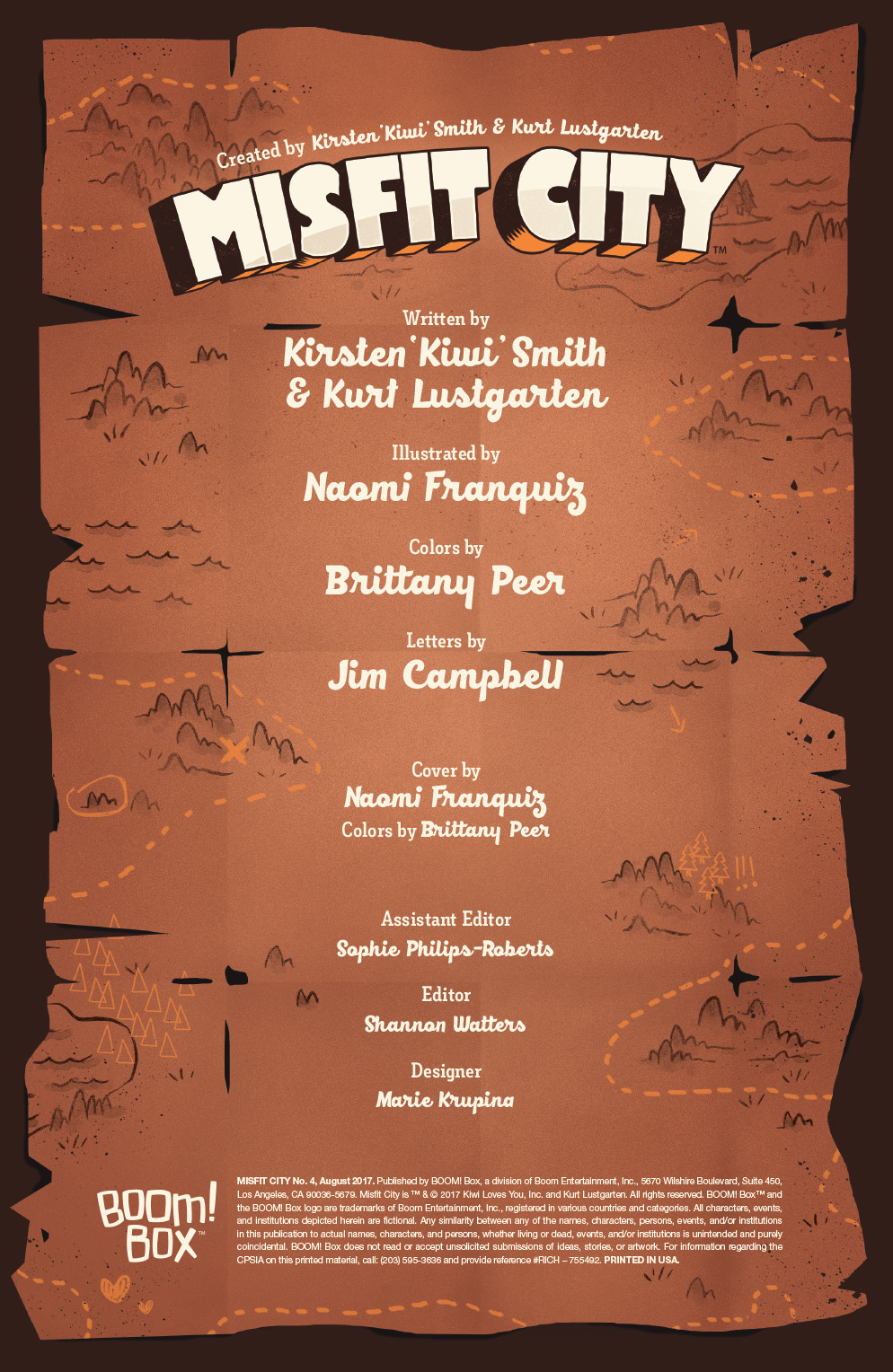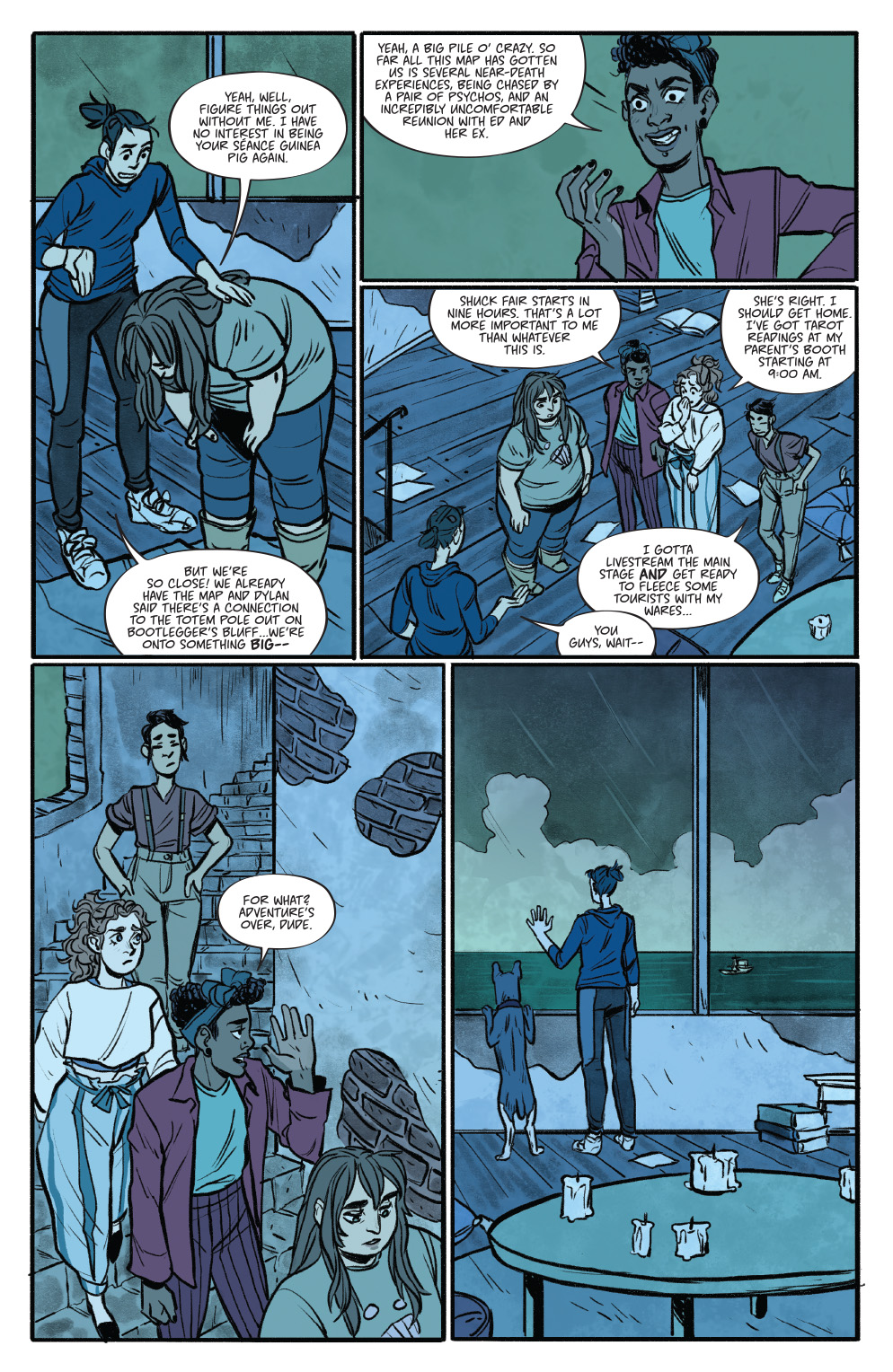
Calling all readers, all ages, for another BOOM! Box exclusive and accessible comic: today we’re talking Misfit City, the recent series by Kiwi Smith, Kurt Lustgarten, and artist Naomi Franquiz. A mixture of sarcastic sleuthery, nostalgia, anti-nostalgia, and witty repartee ricocheting among a diverse cast of young women, all wrapped around a sort-of-homage to The Goonies, Misfit City is the kind of breezy summer comic that brings easy laughs and comfort.
The first draw upon opening the book is the artwork of relative newcomer Naomi Franquiz, who injects lively characterizations into the cast, all of whom live in a small blustery northwestern town, with blustery personalities to match. Franquiz deftly captures each groaning eye-roll from Macy, chipper encouragement from character Karma, or eager puppy-response from Pip; it’s an example of a well-thought out design where you could instantly tell each person apart if the comic was in black and white.
Meanwhile, the writing team of Kiwi Smith and Kurt Lustgarten—film vets getting their hands dirty on comic ink—keep the banter at pace with the plot. Certain members of the crew hover into the forefront, but everyone gets their time to shine throughout, and most readers will zero-in on their distinct favs. This is a character-based series, so it’s a good thing the characters are this smart, charismatic, and diverse, and their effective chemistry together ensures that the slower-paced moments are just as fun as the rest.
We thank Smith, Lustgarten, and Franquiz for taking some precious time from their mystery-solving schedules to answer some questions for Black Girl Nerds.
And let’s not forget: the original Misfit City story arc will end with issue #4, which releases on August 16th. And speak of the devil, we have an exclusive preview of the new issue right here! You’ll find it below the Q&A.
Leonardo Faierman, Black Girl Nerds: How did you first get into reading comics? And following that, when did you decide to start creating your own and/or enter the industry?
KIWI SMITH: I’m relatively new to comics, beginning with a few years ago, when I was sent Lumberjanes to consider a possible screenplay adaptation. It was so vibrant and funny and femme-powered; I got really intrigued by the creators and the world and it led me to meet Shannon Watters (co-creator of Lumberjanes, and also an editor at BOOM! Box) on Twitter. Shannon emailed me to ask if I’d ever thought of writing a comic or graphic novel, and it had always been something I’d fantasized about, although had no idea how to do it. Fortunately, she gave me tons of examples of scripts so I could learn the format, and was very patient with me as I bounced ideas at her for a good long time before we finally landed on Misfit City.
KURT LUSTGARTEN: We were doing a little road-tripping up in Washington state, and we passed through Astoria, Oregon, where The Goonies was filmed. I’m a massive fan, so I shouldn’t make it sound like we “passed through” by accident. We drove into town blasting the Cyndi Lauper theme from the movie and we had this thought: What if everyone who comes to this town does this exact same thing? Do these people have to put up with Goonies fans doing this all day long?
KIWI: We got really inspired by the idea of telling a story about kids who live in a place famous for being the location of a classic kids treasure hunt movie. They’re really jaded about treasure hunting…until then they get pulled into a treasure hunt themselves.
Of all the ideas I pitched to Shannon, this felt the most comic-friendly and cinematic at the same time. And it had the bonus of Kurt and I being able to write it together. I could bring my female friendship/lady power obsession and he could bring his adventure-seeking, comic book-loving expertise.
KURT: I love comics and grew up reading Batman/Detective Comics and Eastman and Laird’s Teenage Mutant Ninja Turtles.
NAOMI FRANQUIZ: I first got into reading comics as a kid—Archie, Shonen Jump, any and every comic that my older brothers brought home (so a lot of Spawn, so much Spawn). I fell in love with the medium, and I used to make my own little homemade comics and zines in middle school with my best friend (whose dad was a huge comic book geek, too, and taught me a lot about it). It wasn’t until after university and leaving the bitter criticism of the fine arts world (wherein “illustration” and “comic books” were treated like four-letter words) that I started to try and make some mini-comics and get my work out there. For as long as I’ve been an artist, it’s only been within the last few years that I’ve solidly considered myself a comic book/sequential artist thanks to group anthologies like [editor Joamette Gil’s] Power & Magic.
BGN: Can you describe your collaborative writer’s process in Misfit City? It’s relatively unusual—though not unheard of—for comics to feature two writers. Is the writing work equally divided between you? Does someone “run point” on the bulk of the narrative while the other supports and edits the text, or is it an organic process front-to-back? Are there fistfights over who gets top billing?
KIWI: We pass the outline back and forth and then break story out loud a bit, then we’ll divide up scenes. I’d say Kurt runs point on big picture treasure hunt stuff, whereas I love writing anything relationship-y or anything involving Karma, Pippin, or Macy singing rock songs. Kurt generally takes first crack on anything involving action set pieces, obscure knowledge from Dot, and/or scrimshaw. I’ll do a final pass which usually involves a small “fistfight” or two…. especially since we live together as well as write together. We’ve tried to instill spaces or times to NOT talk about the story and the characters, but we invariably break those rules because we love our characters so much and we’re always coming up with ideas that we can’t help but pitch the other person in the most inopportune moments. “I love that idea, but do you mind? I’m peeing.”
BGN: Misfit City features a wide range of characters (mostly women) on the page, including characters with varying body-types. Has representing body diversity been an emphasis in your work? Do you use photographic references and, if so, are there individuals you referenced for the main characters in the comic?
NAOMI: A huge pet peeve of mine in comics and character design is the lack of design and variety in character body shapes. So many silhouettes look too similar, and I am surrounded by far too many wonderful and amazing people of all sizes to not want to try and represent them (and myself) in my work. I use photo references a lot (as no artist should be ashamed to admit), but the body types in Misfit City are really inspired by some of my closest friends that I grew up with. Wilder’s height, for instance, is based on one of my best friends, a tall, gangly, wonderfully bold and charismatic woman who once attempted to hide herself behind me, a 5’3” chick. It, uh… it didn’t work
BGN: Do you find that working on comics aligns conveniently with your film-writing/production background? Are there greater challenges or benefits to writing a story with the comics medium in mind? Do you think Misfit City is just the start of your work in this space?
KIWI: It’s been a perfect alignment because I love breaking story and building an outline in collaboration with a partner, and that’s what I’ve been doing as a screenwriter for 20+ years. So, Kurt and I map out the arcs in advance obviously, in both macro and micro ways. Sometimes in the writing it changes, and our editors Shannon and Sophie [Philips-Roberts] at BOOM! have been really lovely and supportive about those digressions, whereas in film you have less leeway. And Kurt’s commercial directing background, in terms of storyboarding and framing, has been super helpful in terms of us learning to write in panels.
For the first few issues, I had to write in Final Draft and then translate it into a comic script, but then Kurt talked me out of that, and now we write like Real Comic Writers.
KURT: We’re getting better at paneling as we go, and thinking in a static image, and because this past year has been such a big learning curve, we’d love to continue in comics because we finally feel like we’re getting our footing. So, we’re keeping a running list of graphic novel and comic ideas. We’re itching to create a new series.
BGN: What are your backgrounds in terms of the places you grew up in, and does this play a part in the Misfit City story at all?
NAOMI: I’m as far away from the Pacific Northwest as you can get in the States—Florida. My family members, however, are island folk and many of my influential memories come with coastlines and the ocean, so certain recurring gags in Misfit City (fishing puns, pesky seagulls, and remarkably salty old men) are things I’m very familiar with.
KURT: Kiwi grew up in the Northwest, primarily in Washington on the Olympic Peninsula, and it’s one of the most beautiful places on Earth. I grew up in the Northeast watching The Goonies and dreaming of growing up in a place like that. So, the setting is both grounded in experience but still carries a feeling of nostalgia.
BGN: Naomi, in your Twitter bio you self-identify as “queer ace.” I feel like we’re slowly seeing more prominently presented ace characters in fiction and media – would you agree with this statement? Are there any characters you see in contemporary media that represent these aspects, or that you feel a kinship with? Are any of the characters in Misfit City ace (even if this is only in your head-canon)?
NAOMI: I do agree that there’s definitely more ace/aro characters slowly cropping up and owning it in stories these days, some of which I feel like I knew was canon all along. Jughead Jones is the first major name I can think of. I grew up reading those Archie Digest books you pick up in the grocery check-out, and Jughead was always my favorite and who I connected with most. He wasn’t bothered with dating or making out or looking hot. Dude just wanted a burger, and I felt that on a real level so seeing it made canon made me really excited.
Haruhi Fujioka in Ouran High School Host Club is another great example. The US version of the British TV series, Sirens, also introduced a canonically ace character (nicknamed “Voodoo”), and thoroughly rebuked the ignorance most people have about aces. She’s not “waiting for the right person,” like everyone keeps insisting. As for Misfit City, I completely head-canon that Dot is the Major Ace of the group. She’s my Jughead, but instead of being in love with food, she’s in love with books and mystery.
BGN: What else might you recommend to readers who really enjoyed Misfit City?
NAOMI: BOOM! Box is putting out a lot of great projects like Lumberjanes, but outside of them, Gotham Academy would be another great dig for more adventure and intrigue.
KURT: Everything Kiwi mentions below plus Gotham Academy, Rat Queens, and Monstress.
KIWI: Lumberjanes, Giant Days, Paper Girls, the graphic novel Lucky Penny, and anything Naomi does in the future. She is an incredible talent, and we feel so lucky to have been teamed with her by BOOM! Her work is a gift to this series in so many ways. We love you, Naomi!
Misfit City #4 releases on August 16th. Here’s the sneak preview of the new issue!











